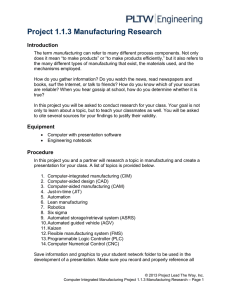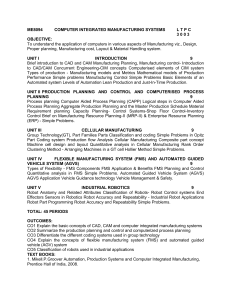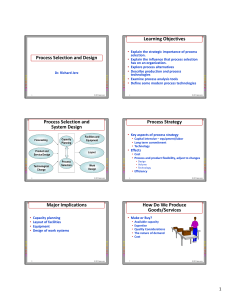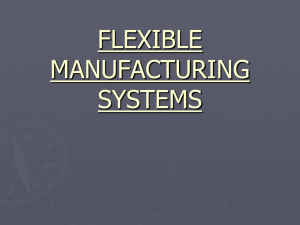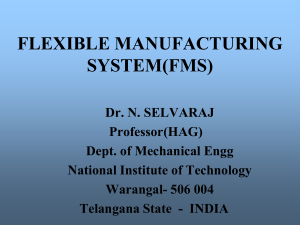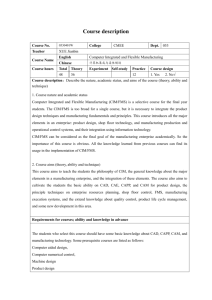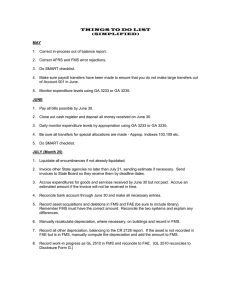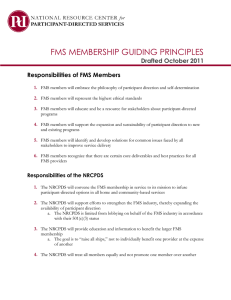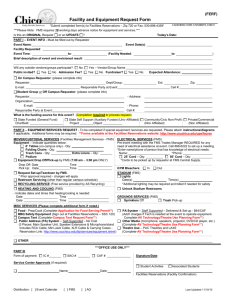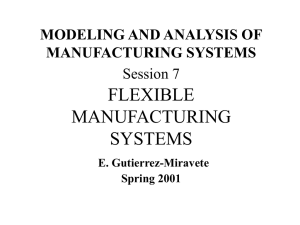Flexible Manufacturing Systems
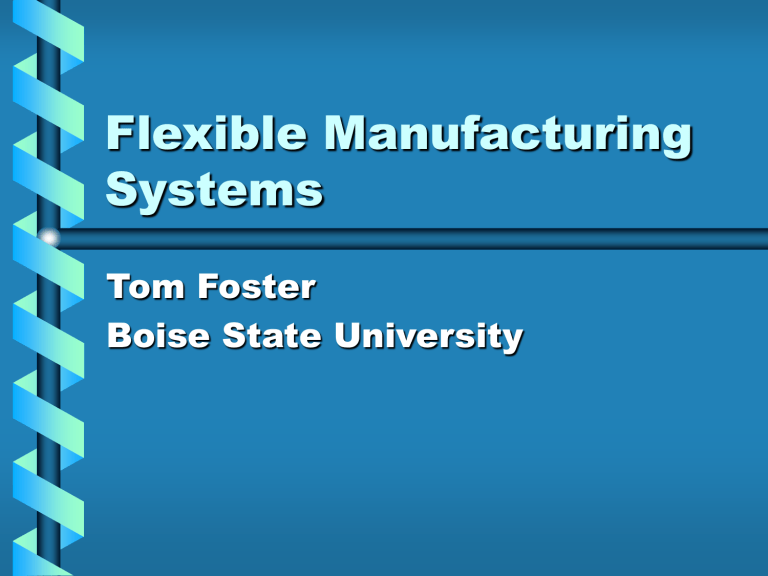
Flexible Manufacturing
Systems
Tom Foster
Boise State University
Flexible Manufacturing
Systems (FMS)
• An FMS is a “reprogrammable” manufacturing system capable of producing a variety of products automatically. Conventional manufacturing systems have been marked by one of two distinct features:
– The capability of producing a variety of different product types, but at a high cost (e.g., job shops).
– The capability of producing large volumes of a product at a lower cost, but very inflexible in terms of the product types which can be produced (e.g., transfer lines).
• An FMS is designed to provide both of these features.
FMS Components
• Numerical Control (NC) machine tools
• Automated material handling system
(AMHS)
– Automated guided vehicles (AGV)
– Conveyors
– Automated storage and retrieval systems
(AS/RS)
• Industrial Robots
• Control Software
Flexible Manufacturing System
Computer control room
Tools
Conveyor
Machine Machine
Pallet
Parts
Load Unload
Terminal
Finished goods
Classification of FMSrelated Problems
• Strategic analysis and economic justification, which provides long-range, strategic business plans.
• Facility design, in which strategic business plans are integrated into a specific facility design to accomplish long-term managerial objectives.
• Intermediate-range planning, which encompasses decisions related to master production scheduling and deals with a planning horizon from several days to several months in duration.
• Dynamic operations planning, which is concerned with the dynamic, minute-to-minute operations of
FMS.
FMS Problems
• Part type selection (Askin) - selecting parts that will be produced in the FMS over some relatively long planning horizon.
• Part selection (Stecke) - from the set of parts that have current production requirements and have been selected for processing in the FMS, select a subset for immediate and simultaneous processing.
• Machine grouping (Stecke) - partition machines into groups where each machine in a group can perform the same set of operations.
• Loading (Stecke) - allocate the operations and required tools of the selected part types among the machine groups.
• Control - provide instructions for, and monitor the equipment in the FMS so that the production goals identified by the above problems are met.
Information Technology
• Management information system
(MIS)
–move large amounts of data
• Decision support system (DSS)
–add decision making support
• Expert system
–recommend decision based on expert knowledge
Decision Support
System
Decision Support System
Data
Management Information System
Computer system: data processing
Information: reports model results what if?
analysis
Management
Personnel
Accounting
Production
Marketing
Distribution
Other areas
Quantitative techniques
What -if? analysis
Decisions
Artificial Intelligence
• Neural networks
–emulate interconnections in brain
• Genetic algorithms
–based on adaptive capabilities in nature
• Fuzzy logic
–simulate human ability to deal with ambiguity
Advanced
Communications
• Electronic data interchange (EDI)
• Internet
• Wireless communications
• Teleconferencing
& telecommuting
• Bar coding
• Virtual reality
Manufacturing
Technology
• Numerically controlled (NC) machines
–controlled by punched tape
• Computer numerical controlled (CNC)
–controlled by attached computer
• Direct numerical control (DNC)
– several NC machines controlled by single computer
Automated Material
Handling
• Conveyors
• Automated guided vehicle (AGV)
• Automated storage & retrieval system (ASRS)
Flexible Manufacturing
Systems (FMS)
• Programmable machine tools
• Controlled by common computer network
• Combines flexibility with efficiency
• Reduces setup & queue times
Robotics
• Programmable manipulators
• Follow specified path
• Better than humans with respect to
–hostile environments
–long hours
–consistency
Robot Parts
• Controller
–hardware, software, power source
• Manipulator
–robot arm
• End-effector
–“hand”
Computer Integrated
Manufacturing (CIM)
• Integration of design, manufacture & delivery via computer technology
• CAD - uses software to create & modify designs
• CAM - uses programmable automation in manufacturing
• CAE - links functional design to CAD form design
• CAPP - creates processing instructions for CAM
• GT- classifies designs to benefit from prior experience
Components Of CIM
GT CAD CAE DFM
IGES,
PDES,
DMIS
TQM
Bar codes,
EDI
MRP
JIT/ kanban
DSS/ES/
AI
LAN, TOP, satellites
Systems management
Product design
CIM
Manufacture
Process planning
CAD/CAM
CAPP
Cellular manufacturing
MAP,
STEP
NC/CNC/
DNC
FMS Robotics
AGV,
ASRS
Automated inspection
Cells and centers
Adoption Of Technology
• Technology Readiness
• Need well-designed products & efficient processes
• Technology Design
• Know what to automate
• Technology Selection
• Choose the right level
• Technology Integration
• Have a strategy for incremental automation
